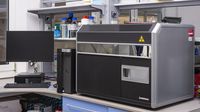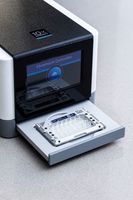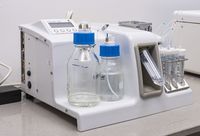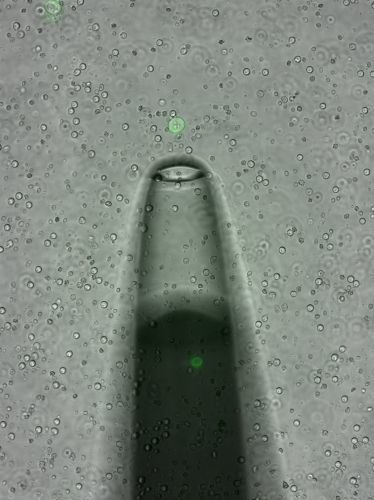Department of Translational Oncology
Institute of Medical Biotechnology and Experimental Oncology
CORE FACILITY ACTIVITIES
As a part of the Excellence Initiative – Research University Program, a new scientific laboratory – Single Cell Analysis Laboratory (LAPK) – has just started its activity at the Medical University of Gdańsk. LAPK is based on the experience of employees of the Department of Translational Oncology of the Medical University of Gdańsk, which was established within the structure of the Intercollegiate Faculty of Biotechnology of the University of Gdansk and the Medical University of Gdansk.
The main goal of LAPK is to conduct scientific activities in the area of molecular and functional analyses at the single cell level. Such analyses allow for an in-depth understanding of the molecular processes occurring in cells and their interaction with the surrounding microenvironment, resulting in a better understanding of the basis of diseases and their more effective treatment. LAPK primarily focuses on the study of tumor cells, with an emphasis on circulating tumor cells. However, the versatility of the research workshop allows for collaboration with interested research teams at GUMed and UCK in other research areas, especially in the context of Priority Research Areas (oncology, cardiology and cardiovascular medicine, and biochemistry, genetics and molecular biology).
Thanks to the expertise of the hired specialists, LAPK will reinforce the interdisciplinary nature of the scientific, research, development and pre-implementation works conducted at the MUG, and will enable cooperation with external entities in Poland and abroad.
Our potential
- Flow cytometer with imaging function
- TransferMan 4r Micromanipulator, Eppendorf
- Chromium Controller from 10x GENOMICS
- Parsortix® Technology System
Flow cytometer with imaging function

Amnis® ImageStream®XMArk II (Luminex)
A system for identifying and visualizing cell populations with selected parameters (e.g., size, phenotype, degree of granularity) that combines features of flow cytometry and high-resolution fluorescence microscopy. Allows identification of cells in 12 channels and determination of approximately 75 cell features (e.g. staining intensity, area, diameter), at 200x, 400x or 600x magnification and lasers 405nm, 488nm, and 642nm. The device has applications in all areas of molecular biology (e.g. phenotyping, localization analysis of selected agents) and fields (e.g. oncology, microbiology, stem cell biology).
Advantages:
- combines the advantages of flow cytometry (speed of analysis, gating of cell populations) and high-resolution fluorescence microscopy (visualization of all analyzed cells);
- enables multi-factor analysis of cells, including analysis of factors in 9 fluorescent channels.
Price list:
The laboratory will perform research according to individual projects both as a service activity and as a co-participation in a scientific research project. Pricing of the analysis is done individually according to the specific project.
TransferMan 4r Micromanipulator, Eppendorf
System for micromanipulation-based isolation of single cells (groups of cells) connected to a ZeissAxiovert 200 inverted fluorescence microscope equipped with a set of five filters for fluorescence detection. The kit allows isolation of live unstained or (immuno)fluorescent-labeled cells from a suspension (e.g., circulating tumor cells) for further gene expression profiling in single cells using qPCR or RNA- Seq.
Advantages:
- the ability to isolate any selected cell (cell groups) from suspension;
- the ability to analyze live cells and their subsequent transcriptomic (based on Smart-Seq2 material isolation and preamplification technology) or genomic profiling.
Price list: The laboratory will perform research according to individual projects both as a service activity and as a co-participation in a scientific research project. Pricing of the analysis is done individually according to the specific project.

Chromium Controller from 10x GENOMICS
The operation of the device is based on 10x GEMCode technology, using the principle of microflow to carry out the separation of a suspension of hundreds to tens of thousands of cells into media containing the appropriate indices, making it possible to create libraries for sequencing, corresponding to single cells. Single cell profiling has the advantage of integrated cell-by-cell analysis, allowing the heterogeneity of cells within a population to be examined. The procedure has been validated to work on fresh or frozen samples, allowing the technology to be applied to a broad spectrum of biological material.
Practical applications:
- Transcriptomics
The Chromium Controller from 10x GENOMICS enables complete characterization and profiling of gene expression in thousands of cells simultaneously. Additionally, with the Feature Barcoding solution, it is possible to obtain information about cell surface proteins. The result of such an experiment will be information about the transcriptome and the presence of surface proteins for each cell analyzed.
- Immunological profiling
The Chromium Controller also allows the parallel analysis of thousands of lymphocytes to define their differentiation for a specific and effective immune system response. It is useful in immunology, immuno-oncology or in the study of infectious diseases.
Price list: The laboratory will perform research according to individual projects both as a service activity and as a co-participation in a scientific research project. Pricing of the analysis is done individually according to the specific project.

Parsortix® Technology System
The single cell isolation system, based on innovative cell separation according to cell size and deformability, enables the capture of live circulating tumor cells (CTCs) from peripheral blood collected from patients into EDTA samples (also known as liquid biopsy).
Advantages:
- the Parsortix® system is a simple and efficient way to capture and concentrate CTCs, regardless of their phenotype;
- CTC isolation provides the opportunity to obtain material for a wide range of further molecular analyses, such as protein expression and DNA/RNA analysis;
- the device does not require pre-treatment of the blood sample, significantly reducing the CTC isolation time and their leukocyte contamination.
Price list: The laboratory will perform research according to individual projects both as a service activity and as a co-participation in a scientific research project. Pricing of the analysis is done individually according to the specific project.
The purchase of the infrastructure (Chromium10x Genomics, Parsortix®) for LAPK was funded under the Ministry of Science and Higher Education’s “Excellence Initiative – Research University” program.
Contact
Beata Pieczyńska-Uziębło, Ph.D.
Department of Translational Oncology
Institute of Medical Biotechnology and Experimental Oncology
Intercollegiate Faculty of Biotechnology UG and GUMed ul. Dębinki 1, 80-211 Gdańsk
Phone +48 58 349 1438
E-mail beata.pieczynska-uzieblo@gumed.edu.pl
In addition, we encourage you to use the services of the Centre of Biostatistics and Bioinformatics Analysis, with its experienced team providing comprehensive support in planning, designing, managing and reporting scientific research, especially with the use of LAPK device (link to the Centre’s website below).


